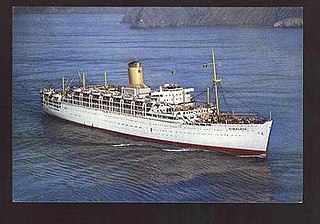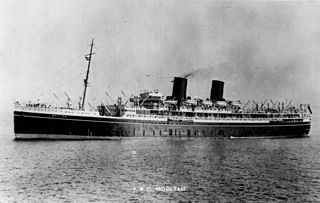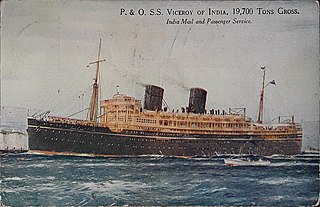
SS Canberra was an ocean liner, which later operated on cruises, in the P&O fleet from 1961 to 1997. She was built at the Harland and Wolff shipyard in Belfast, Northern Ireland at a cost of £17 million. The ship was named on 17 March 1958, after the federal capital of Australia, Canberra. She was launched on 16 March 1960, sponsored by Dame Pattie Menzies, wife of the then Prime Minister of Australia, Robert Menzies. She entered service in May 1961, and made her maiden voyage starting in June. In the 1982 Falklands War she served as a troopship. In 1997 the singer and songwriter Gerard Kenny released the single "Farewell Canberra" which was specially composed for the last voyage.

SS Oceanic was the White Star Line's first liner and first member of the Oceanic-class, she was an important turning point in passenger liner design. Entering service in 1871 for Atlantic crossings, she was later chartered to Occidental and Oriental Steamship Company (O&O) in 1875. The ship provided passenger service for O&O in the Pacific until 1895 when she was sold for scrap.

SS Himalaya was a British passenger ship of the Peninsular and Oriental Steam Navigation Company, launched in 1948, which operated mainly between Britain and Australia. She was withdrawn from service in 1974 and scrapped the next year.

SS Argentina was a US turbo-electric ocean liner. She was completed in 1929 as SS Pennsylvania, and refitted and renamed as SS Argentina in 1938. From 1942 to 1946 she was the War Shipping Administration operated troopship Argentina. She was laid up in 1958 and scrapped in 1964.

The first RMS Windsor Castle, along with her sister, RMS Arundel Castle, was an ocean liner laid down by the Union-Castle Line for service from the United Kingdom to South Africa. During World War 2 the Windsor Castle was requisitioned as a troopship and on 23 March 1943 was sunk by an aerial torpedo off the coast of Algeria.

RMS Mooltan was an ocean liner and Royal Mail Ship of the Peninsular and Oriental Steam Navigation Company (P&O). She was ordered in 1918 and completed in 1923. She served in the Second World War first as the armed merchant cruiser HMS Mooltan (F75) and then as a troop ship. She was retired from P&O service in 1953 and scrapped in 1954.

RMS Viceroy of India was an ocean liner of the Peninsular and Oriental Steam Navigation Company (P&O). She was a British Royal Mail Ship on the Tilbury–Bombay route and was named after the Viceroy of India. In World War II, she was converted to and used as a troopship. She was sunk in the Mediterranean in November 1942 by German submarine U-407.

SS Ranchi was Peninsular and Oriental Steam Navigation Company "R"-class steam ocean liner that was built in 1925 and scrapped in 1953. From 1939 to 1943 she was the Royal Navy armed merchant cruiser HMS Ranchi.

RMS Sylvania was an ocean liner built in 1957 by John Brown & Co (Clydebank), in Glasgow, for the United Kingdom-based shipping company Cunard Line. She was the last Cunard Line vessel built specifically for transatlantic crossings. The ship was later heavily rebuilt as a cruise ship, and sailed under the names SS Fairwind, SS Sitmar Fairwind, SS Dawn Princess and SS Albatros before being scrapped in 2004. She was renamed SS Genoa for her last voyage.

SS California was the World's first major ocean liner built with turbo-electric propulsion. When launched in 1927 she was also the largest merchant ship yet built in the US, although she was a modest size compared with the biggest European liners of her era.

RMS Orion was an ocean liner launched by the Orient Steam Navigation Company in 1934 and retired from the water in 1963 after carrying about 500,000 passengers. A 23,371 ton passenger ship, the Orion was built to carry 486 first class, 653 tourist class passengers and 466 crew from Europe through the Pacific to Australia. The construction of the ship was documented in Paul Rotha's 1935 film Shipyard.

RMS Strathnaver, later SS Strathnaver, was an ocean liner of the Peninsular and Oriental Steam Navigation Company (P&O).

The first RMS Saxonia was a passenger ship of the British Cunard Line. Between 1900 and 1925, Saxonia operated on North Atlantic and Mediterranean passenger routes, and she saw military service during World War I (1914–1918).

SS Brazil was a US turbo-electric ocean liner. She was completed in 1928 as Virginia, and refitted and renamed Brazil in 1938. From 1942 to 1946 she was the War Shipping Administration operated troopship Brazil. She was laid up in 1958 and scrapped in 1964.

RMS Strathmore was an ocean liner and Royal Mail Ship of the Peninsular and Oriental Steam Navigation Company (P&O), the third of five sister ships built for P&O in the "Strath" class. Launched in 1935, she served on the company's route from London to India until 1940, when she was requisitioned for war service as a troop ship, and redesignated as SSStrathmore, until being returned to her owners in 1948. After a long re-fit, she resumed service with P&O from 1949 until 1963, when she was sold to Latsis Lines and renamed Marianna Latsi, then Henrietta Latsi, before being laid up in 1967 and finally scrapped in 1969.

SS Cathay was a P&O passenger steamship that was built in Scotland in 1925 and sunk in the Mediterranean Sea in 1942. In the Second World War she was first an armed merchant cruiser and then a troop ship. In 1942 she took part in Operation Torch, and was sunk in a German air raid off Bougie, Algeria.
RMS Andes was a 26,689 GRT steam turbine Royal Mail Ship, ocean liner, cruise ship, and the flagship of the Royal Mail Lines fleet. She was the second Royal Mail ship to be named after the South American Andes mountain range. The first RMS Andes was an A-class liner launched in 1913. In 1929 that RMS Andes was converted into a cruise ship and renamed Atlantis.

SS New Australia was a UK-built turbo-electric passenger steamship that had a varied career from 1931 to 1966. She was built as the ocean liner Monarch of Bermuda, was a troop ship in the Second World War and was damaged by fire in 1947.

SS Queen of Bermuda was a British turbo-electric ocean liner that belonged to Furness, Withy & Co Ltd. Its Furness Bermuda Line subsidiary operated her between New York and Bermuda before and after the Second World War. During the war she served as first an armed merchant cruiser and then as a troop ship.

SS Stratheden was a UK-built steam turbine ocean liner. She spent most of her career with the Peninsular and Oriental Steam Navigation Company, including the Second World War when she served for six years as a troop ship.




















